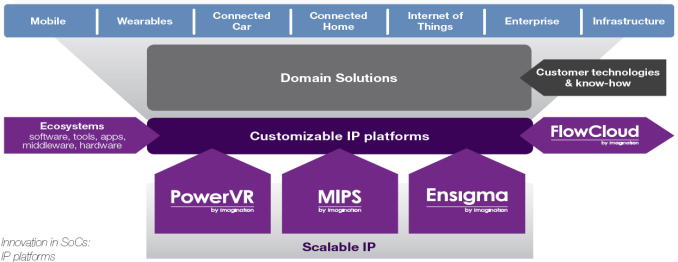CEO of Imagination Technologies Steps Down
by Anton Shilov on February 9, 2016 5:00 AM EST- Posted in
- Imagination Technologies
- CPUs
- GPUs
- PowerVR
- MIPS

Sir Hossein Yassaie, chief executive officer of Imagination Technologies, has stepped down as of Monday, Feburary 8th. Mr. Yassaie served as Imagination’s CEO since 1998 and joined the company in 1992. The company expects to report a loss for the financial year, which may be the reason for CEO’s departure. Andrew Heath, one of the company's non-executive directors, has been appointed interim chief executive. He has already began to search for a new CEO for Imagination.
Imagination licenses graphics, multimedia and general-purpose processing technologies to various chip developers, including Apple and Intel. The company indicated that royalties from some of its key customers have fallen short of previous expectations for the last calendar quarter of 2015. The company also lowered its forecast for Q1 2016. Imagination named global slowdown in the semiconductor sector as well as global uncertainty about future trading prospects with China as the reasons for its financial problems. While Imagination indicated that its licensing pipeline remains strong, it is not sure about its license revenue timing.
Imagination Technologies was founded in 1985 as VideoLogic. The company sold chips for televisions, game consoles and PCs. Mr. Yassaie changed the company’s business model to technology licensing in 1999 and essentially exited chip business several years later. Imagination tried to return to the market of graphics adapters with its Kyro and Kyro II graphics chips in early 2000s, but it could not compete against ATI and NVIDIA at the time. Starting from the year 2000 Imagination bought a number of important technology companies, significantly boosting its IP portfolio. Among the companies acquired by Imagination are Ensigma (digital signal processing), Caustic Graphics (hardware/software for real-time ray-tracing technology), MIPS Technologies (general-purpose processing) and a number of others. Today, Imagination can provide virtually all technologies needed to build system-on-chips for almost all kinds of devices. In fact, Imagination’s graphics processing technologies are used inside billions of smartphones and tablets.
Imagination did not announce when it expects to hire its new CEO, but said that it will consider both internal and external candidates. For a company like Imagination the absence of permanent CEO concerning because it constantly needs to make strategic decisions that have long-lasting effects on its future. Technologies developed by Imagination today will be licensed only a couple of years down the road and it is important for them to be competitive against offerings from ARM as well as developers of proprietary chips. As pointed out by The Tech Report, Mr. Yassaie is the author of the intellectual property licensing model that brought the company to fame, and it will likely not be easy to find a replacement due to the complexity of the technology licensing business.
Alongside Mr. Yassaie's resignation, Imagination also announced additional details on restructuring initiatives, which include the sale of Pure, its consumer electronics business. The company expects to reduce operating costs of its on-going businesses by £15 million in the next financial year, ending April 2017. In addition, Imagination will re-invest £2 million in PowerVR graphics processing technology. The company also plans to analyze its overhead expenses and research and development expenditures before implementing additional restructuring actions.
Source: Imagination Technologies (via The Tech Report)











23 Comments
View All Comments
iwod - Tuesday, February 9, 2016 - link
I always wonder if buying MIPS was a bad move and if it will cost them.PowerVR could have been the ARM for GPU, but turns out most decide to buy the crap Mali from ARM instead. No idea what went wrong there. ( Price ? )
I think MIPS is a losing battle, but it would be nice if something could be added to RISC-V.
mforce - Tuesday, February 9, 2016 - link
I'm not sure why you're calling Mali crap. Not saying it's better than PoverVR but it's not a bad GPU and it's probably convenient for SOC manufacturers to buy everything from ARM.In the long term I don't see PoveVR doing too well since when you have ARM that has a GPU business too they have the power to take over the GPU market for ARM as well.
Sometimes Mali may not be the best performing GPU but for most of the SOCs this isn't really an issue since they don't really need the best performing GPU ( nor do they use it ).
Imagination already lost Intel for their PowerVR licensing and if they loose Apple too I don't see them doing particularly well. All that's left then are the Chinese SOC manufacturers which prefer low cost solutions for the GPU as Samsung always uses Mali and Qualcomm have their Adreno which kicks ass.
Wolfpup - Wednesday, February 10, 2016 - link
Seems like Apple buying Imagination could be realistic if things got bad.I didn't realize Imagination had bought MIPS! So weird how this all works out.
Does anyone but Samsung (and obviously Apple) use PowerVR? Obviously their stuff Apple uses is fantastic, but I can understand most companies just want easy, and pretty much just buy Qualcomm stuff even if it's not that great.
Dmcq - Tuesday, February 9, 2016 - link
It does look like ARMv8 is displacing MIPS and PowerPC from their heartland in networking. I think MIPS was a good idea at the time but sometimes you win and sometimes you lose. Perhaps without it they would have concentrated on the graphics more but a bit of diversity is needed for getting over troubles, I can't see any other downsides.As to RISC-V I can see some attractions but I think it has come too late. For the high end you can see the multi-year effort needed by ARM and you need strong standards,you don't get that for free and by saying people can do their own extensions. At the low end IoT is rewriting the ground rules and you need to have a strong standards for security and rights management. In the middle ARM tried with extensibility for coprocessors years ago and gave it up, RISC-V might do something but really coprocessors are roll your own type things.
Imagination have tried to develop MIPS for the IoT market and done work on security and communications. Why should someone spend money on RISC-V when they can get something from MIPS or ARM with better infrastructure support and at less overall cost? And if they spent their money on developing the infrastructure - which mostly would involve getting deals with other companies - all they'd produce is a market with a lower cost of entry for a competitor.
Samus - Tuesday, February 9, 2016 - link
MIPS has an uphill battle just like Blackberry BBOS, Windows Phone and to some extent Firefox OS do: developers.This is why HP pulled the plug on WebOS so many years ago, they couldn't get developers away from Android and iOS. They made the wrong choice in most peoples opinions (including my own) because WebOS has a lot of superior UI elements, some of which finally made their way into Android and especially iOS. But without HP committing to developers, why would developers commit to them?
I suspect this is the main issue MIPS is having. They aren't going to win developers over without commitment, which is basically required if they seek any desirable market share.
Then there are the technical hurdles of MIPS architecture, which isn't entirely optimized for mobile applications. Most MIPS processors have seen their place in set-top boxes, routers/modems, and some enterprise appliances, not phones/tablets.
Alexvrb - Tuesday, February 9, 2016 - link
That depends on platform. For example, if MS ported Windows 10 to MIPS, they can potentially recompile all the RunTime apps in the cloud. That doesn't help legacy programs, of course.A bigger obstacle is: Do any compelling MIPS SoCs exist that would make such an endeavor worthwhile? Are they substantially better and/or less expensive?
UrQuan3 - Wednesday, February 10, 2016 - link
It does look like ImgTec MIPS is falling behind. When I got to benchmark a CI-20 (dual mips32r2), it proved to be about one-third the performance of a dual ARM A9 at about the same clockspeed. Then again, mips32r2 is *old*. It is way faster than the ARM11 which would have been top of the line when mips32r2 was new. There are several newer cores. The problem is, just like the several PowerVR cores newer than the SGX540, I can hardly find anyone that is using them.gsvelto - Tuesday, February 9, 2016 - link
ARM has been bundling Mali GPUs with low-end ARM cores for a while now, essentially providing the GPU part for free. This has essentially shut out competing GPUs in a wide range of SoCs.colinisation - Tuesday, February 9, 2016 - link
I would have guessed just looking at the marketing material from both companies that even though ARM GPUs tend to be lower down the performance pecking order. ARM have been prioritising power consumption and die area, I mean when I look at all SoC users bar Apple it seems to me they would either go Qualcomm with a bundled GPU or Mali to save die space. What I am trying to say is whilst there is only so much you can draw from marketing slides - it seems to me that Mali is simply targeting the bigger market.jab701 - Tuesday, February 9, 2016 - link
Don't be mistaken about MIPS, many modems/Routers/Networking stuff uses MIPS till and in particular companies are worried about an ARM monopoly. It would be bad for the mobile market (google was concerned about the ARM monopoly in particular). We would end up in a situation like Intel is in the PC market and it would be bad.The problem with MIPS is that many companies are using old cores and need to persuaded to use new cores (which can be licensed for more money).
This is happening but it takes around 12-24 months to develop a new core (dependent if based on a previous design or from scratch) and then it takes 1-2 years before you see it shipping in designs to consumers.
As for PowerVR it is a really nice design, the reason Mali is getting in product is that ARM were offering it for free if a company took a SoftIP CPU core at the same time. Not all companies were happy about this and the PowerVR stuff is designed to work with ARM, both companies sit on the HSA committees etc.
We will just have to wait and see what is in the pipeline :)